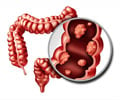A new pathway developed reveals how cancer cells become resistant to chemotherapies. The finding offers a potential solution for preventing chemo-resistance.

Kinase Enzyme and Prevention of DNA Damage in Cancer Cells
“It provides us tools to manipulate and then break chemo-resistance in cancer cells,” said Marcus Smolka, interim director of the Weill Institute for Cell and Molecular Biology and professor of molecular biology and genetics in the College of Agriculture and Life Sciences. Diego Dibitetto, a former postdoctoral researcher in Smolka’s lab who is currently at the University of Bern in Switzerland, is the paper’s first author.‘The study reports how a kinase (enzyme) called DNA-PKcs acts as a sensor when a fork is stressed due to blocks, and promotes slowing of the fork and chemo-resistance.
’





Many anti-cancer drugs work by creating blocks on the DNA of cancer cells as they replicate. During replication, DNA strands entwined in a double helix separate into two individual strands so each strand can be copied, eventually leading to two new double helixes. The junction where this separation and copying occurs is called a replication fork, which unzips down the double helix. If these replication forks were cars on a road, chemotherapy drugs can be imagined as obstacles that interfere with the flow of the cars, thus stopping replication and breaking DNA. But cancer cells have a way of slowing down these forks, which allows them to avoid such collisions and protect their DNA, leading to drug tolerance.
DNA-PKcs has been known for its role in DNA repair related to immune system antibody generation and resistance to radiation. But this is the first time the kinase has been associated with slowing a replication fork, a process called fork reversal.
“It’s a completely new way of thinking about the action of this kinase” Smolka said. “It’s not repairing DNA in this case; it’s slowing down forks to prevent breaks from happening in the first place.”
The results open the door to new cancer treatments, as DNA-PKcs inhibitors already exist and are being used for clinical trials in tandem with radiation therapies. In those treatments, radiation damages cancer cell DNA, and the thought was that inhibiting DNA-PKcs would limit cell repair. But, DNA-PKcs inhibitors don’t work well in that context, as cancer cells have other ways to repair themselves.
Advertisement
In the study, the researchers used an assay to detect the DNA-PKcs kinase at replication forks. Then they used a DNA fiber assay with fluorescent colors, such that the faster the replication forks moved, the longer the fibers became. In the presence of chemotherapy drugs, the fibers were short, pointing to slowed replication forks. But when inhibitors were added in, the fibers remained longer, indicating the forks were moving at faster speeds.
Advertisement
Breast Cancer and Chemotherapy Drugs
Finally, BRCA2 deficient breast cancers can become resistant to chemotherapy drugs used to treat them, and it was known that fork reversal was involved in the resistance. In this study, when the researchers applied DNA-PKcs inhibitors to BRCA2 deficient breast cancer cells that were resistant to treatment, the cells regained sensitivity to the treatment.“This is another way to confirm that being able to prevent slowing and fork reversal through DNA-PKcs inhibitors seems to be a really good way of manipulating chemo-resistance,” Smolka said.
In future work, the research team will investigate how cells sense replication fork stress and what proteins DNA-PKcs interact with to slow these forks.
Source-Eurekalert














